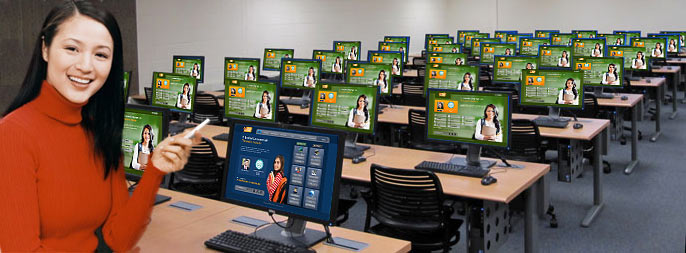
This permits two-way communication for the teacher to communicate with a student. The teacher has three ways for communication: One-on-one texting or typing, One-on-one voice communication and One-on-one audio/video interaction
It is a function to pair and/or group students for debates and/or for group discussions and observe/control them selectively or all-together. The functions a teacher can perform are Chat, Audio and Video.
This function emulates a normal class environment where teacher can conduct live classes and perform online evaluation of student’s activity.
Teachers can create customized learning materials using this standalone studio application quickly and effortlessly. The output could be in Video, Audio & Text formats.
This control functions enables teachers to send written assignments or exercises to the student interface. A teacher can select one or multiple lessons and send the across to a student, a selected group or to all students of the class.
By using this control a teacher can send or assign students with reading lessons or exercise where students can read / refer and answer the questions related to those lessons.
This is a dropdown list of activities or exercises to be undertaken by the student that popup on their monitor in a date-wise ascending order of assignment.
This is a one-way communication tool for the teacher to interact with students individually, in a group or to the whole class through Chat, Audio and Video.
This innovative tool permits the teacher to instantly capture a student’s screen incognito or without the student being aware that he/she is being observed. This permits individualized monitoring of every student activity more effective.
Offering three-dimensional flexibility of application, the View Master permits observation and monitoring of student activity in normal, group and student modes.
This facilitates incognito real-time monitoring of the student interface from the privacy of the instructor’s console. The options include: Observe, Eavesdrop and CamView
This function permits the teacher remote-control of the student interface from the privacy of his/her workstation.
Teacher can create student groups and assign them task by using this control button. This function also lets the students to share and use their resource (Audio, Video or Text files) during the course of assigned task. In addition the students in the group have the option to share their screen and interact
The model student features is a supportive tool which can used by other students to learn and progress .Under this feature the teacher assigns a student as a Model person and rest of class can either follow or refer that particular model student. Some interesting features for other students associated with control function are that they can View Model student’s assignment, Real time listening and Real time webcam viewing of Model student. This feature ensures that other students only refer but not copy or download.
This is a real time screen sharing function for the teacher to show the content of their computer by sharing the screen with one, a group or to all the students over the network. The contents that the teachers can share and show could be in the form of video clip, picture, text file, web pages or any enriched sharable content.
A call for help tool for the students to bring the attention of teacher. This is one click button which can be used by students for call teacher for help or clarification. An alert will appear on the teachers screen to notify.
This noticeboard feature helps the teacher to write a matter or a piece of information as a notice leaving it for the students to view it online or later. A prompt will appear on the student’s home screen to intimate the arrival of new information, where the students need to click to view the same. The students can also go through older noticeboard material at any point in time. The teacher can also setup validity of noticeboard prompts by assigning due dates.
This is another exciting feature for the Teacher which emulates a normal classroom whiteboard, where teacher can type or draw on the board and send that to a single, and a group or to all the students.